Video of the Week:
Spider Mites
Vegetables:
Tomato Cracking
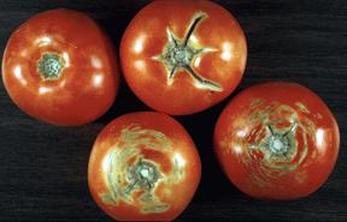
Tomatoes have a root system that is very dense and fibrous and is quite efficient in picking up water. Unfortunately, the root system can become unbalanced with the top of the plant. Early in the season it may be small in relation to the top growth resulting in blossom-end rot during hot dry weather. Later it may be so efficient that it provides too much water when we get rain or irrigate heavily after a dry spell. This quick influx of water can cause the tomato fruit to crack. Therefore, even, consistent watering can help with cracking. Mulching will also help because it moderates moisture levels in the soil. However, you can do everything right and still have problems with cracking in some years.
We have evaluated varieties for cracking during our tomato trials at K-State. It takes several years worth of data to get a good feel for crack-resistant varieties but we have found some real differences. Some varieties crack under about any condition and others are much more resistant. The difference seems to be pliability of skin rather than thickness — the more pliable the skin the more resistance to cracking.
The old variety Jet Star has been the most crack resistant of any we have tested including the newer types. Unfortunately, Jet Star is an indeterminate variety that puts out rampant growth. Newer varieties with more controlled growth are often more attractive to gardeners. Mountain Spring, Mountain Pride, Mountain Fresh, Floralina and Sun Leaper are smaller-vined types that have shown good resistance to cracking. (Ward Upham)
How to Pick a Ripe Melon
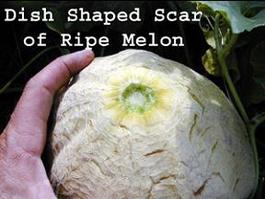
When choosing a melon from those that have already been harvested, look for a clean, dish-shaped scar. Also, ripe melons have a pleasant, musky aroma if the melons are at room temperature (not refrigerated).
Watermelons can be more difficult and growers often use several techniques to tell when to harvest.
1. Look for the tendril that attaches at the same point as the melon to dry and turn brown. On some varieties this will need to be completely dried before the watermelon is ripe. On others it will only need to be in the process of turning brown.
2. The surface of a ripening melon develops a surface roughness (sometimes called “sugar bumps”) near the base of the fruit.
3. Ripe watermelons normally develop a yellow color on the “ground spot” when ripe. This is the area of the melon that contacts the ground.
Honeydew melons are the most difficult to tell when they are ripe because they do not “slip” like muskmelons. Actually, there is one variety that does slip called Earlidew, but it is the exception to the rule. Ripe honeydew melons become soft on the flower end of the fruit. The “flower end” is the end opposite where the stem attaches. Also, honeydews should change to a light or yellowish color when ripe, but this varies with variety. (Ward Upham)
Fruit:
Watering Fruit Plants During the Summer
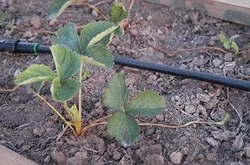
The stress may also reduce the development of fruit buds for next year's fruit crop. If you have fruit plants such as trees, vines, canes, and such, check soil moisture at the roots. Insert a spade or shovel or a pointed metal or wood probe -- a long screwdriver works well for this. Shove these into the soil about 8 to 12 inches. If the soil is hard, dry, and difficult to penetrate, the moisture level is very low, and plants should be irrigated to prevent drooping and promote fruit enlargement. Water can be added to the soil using sprinklers, soaker hose, drip irrigation, or even a small trickle of water running from the hose for a few hours. The amount of time you irrigate should depend upon the size of plants and the volume of water you are applying. Add enough moisture so you can easily penetrate the soil in the root area of the plant with a metal rod, wooden dowel or other probe. When hot, dry weather continues, continue to check soil moisture at least once a week.
Strawberries have a shallow root system and may need to be watered more often – maybe twice a week during extreme weather. Also, newly planted fruit trees sited on sandy soils may also need water twice a week. (Ward Upham)
Prop Up Fruit Tree Limbs if Needed
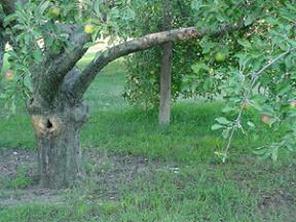
Here's how. Cut a "V" on the top edge of the board on which the limb will rest so that it doesn't slip off. Long limbs that are heavily loaded with fruit may need a prop in the center and another to support the outer part of the limb. A plastic belt-like material that is about 2 inches wide may also be used. This can be tied to a heavily loaded limb, then to a large diameter limb above for support. Where a large limb is used for support, it is good to have it supporting limbs on opposite sides so the weight is balanced. Another solution is to wrap a tape or belt material around the tree in a spiral to prevent limbs from bending until they break. Heavy twine may be used, but it should be removed when the fruit is picked or soon after so it does not cut into the bark on the limb.
Check trees regularly, up to two times a week during the last month the fruit are maturing. You will find additional limbs that need support. Tending to the heavily loaded tree limbs will reduce the number of broken limbs and help keep a balance of the fruiting wood in your tree. Next year, prune long, weak branches back to a side branch to help prevent this problem. (Ward Upham)
Tan or White Drupelets on Blackberry and Raspberry Fruit
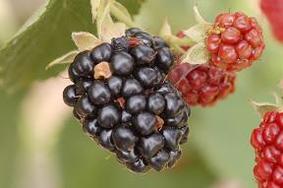
Neither condition affects the eating quality of the fruit unless the stink bug releases the “stink” with which it is associated rendering the fruit inedible. By the time damage is seen, it is too late for control. (Ward Upham)
Ornamentals:
Watering Newly Planted Trees and Shrubs
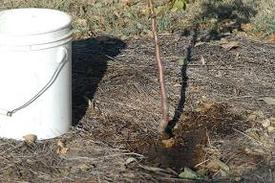
Deep, infrequent watering and mulching can help trees become established. Newly transplanted trees need at least 10 gallons of water per week, and on sandy soils they will need that much applied twice a week. The secret is getting that water to soak deeply into the soil, so it evaporates more slowly and is available to the tree’s roots longer. One way to do this is to punch a small hole in the side of a 5-gallon bucket and fill it with water. Let the water dribble out slowly next to the tree. Refill the bucket once, and you have applied 10 gallons. Very large transplanted trees and trees that were transplanted two to three years ago will require more water.
A perforated soaker hose is a great way to water a newly established bed or foundation planting. In sunbaked soil, you may need to rough up the surface with a hoe or tiller to get water to infiltrate easily. It may be helpful to set the kitchen oven timer, so you remember to move the hose or shut off the faucet. If you are seeing surface runoff, reduce the flow, or build a berm with at least a 4-foot diameter around the base of the tree to allow the water to percolate down through the soil, instead of spreading out.
Regardless of method used, soil should be wet at least 12 inches deep. Use a metal rod, wooden dowel, electric fence post or something similar to check depth. Dry soil is much harder to push through than wet. (Ward Upham)
A Case for Screens
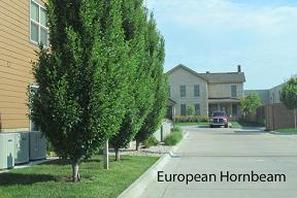
It’s important to be aware of the mature size of the plant as well. Sure, they look so small and skinny when you plant them, but when they start to grow into each other and you can’t mow around them anymore it becomes a problem. Be aware of how much space you have for them to grow (wide) and how tall you need them to be in order to solve the privacy or view problem.
So, let’s get into some plant recommendations, starting with evergreen. Assuming that you want these plants to get to at least 15 to 30 feet tall, you can consider a Chinese juniper such as Juniperus chinensis ‘Hetzii Columnaris’ or a white pine (Pinus strobus ‘Fastigiata’). A tough-as-nails option that is used quite frequently is a cultivar of Eastern redcedar (Juniperus virginiana) called ‘Taylor’ which is a release from the Nebraska Statewide Arboretum and was found in a pasture near Taylor, NE. Some winter browning has been reported in exceptionally cold years, but the plants recover quickly.
There are quite a few more options in the deciduous category and most can get quite tall. Let’s start with the shortest of the bunch, which is a ginkgo with outstanding bright yellow fall color: Gold Spire ginkgo (Ginkgo biloba ‘Blagon’) that grows 14 to 16 feet tall and 5 to 6 feet wide. European Hornbeam (Carpinus betulus ‘Franz Fontaine’) is a popular option with clean, bright green foliage growing 30 feet tall by 10 feet wide. Mature tuliptrees (Liriodendron tulipifera) will really make heads turn when they sport large, tulip-shaped flowers in the spring. The columnar cultivar ‘Fastigiatum’ grows 50 to 60 feet tall and 20 feet wide.
I would be remiss not to mention a cultivar plucked right out of the Great Plains in Kansas. Prairie Sentinel® Hackberry (Celtis occidentalis ‘JFS-KSU1’) stuck it’s tall canopy out of the rural prairie and just called out for propagation. It can grow up to 45 feet tall and 12 feet wide. It’s also just as tough-as-nails as Eastern redcedar.
How about a Zelkova? These upright trees have a vase-shaped architecture (they are quite narrow at the bottom and wide at the top, a little like an upside down pyramid) they make great canopies over roads. The columnar version of this species is Zelkova serrata ‘Musashino’ and grows 45 feet tall and 15 feet wide.
Another relatively columnar tree not seen nearly enough is Shawnee Brave® Baldcypress (Taxodium distichum ‘Mickelson’). Baldcypress can be a confusing tree to folks who aren’t “in the know.” It looks like an evergreen, and in fact it is a conifer, but it’s a deciduous conifer. It’s feathery sage-green leaves turn pumpkin-brown in the fall and drop to the ground. This species can get huge, both tall and wide, but Shawnee Brave® grows to a mere 55 feet tall and 20 feet wide. Since this species tolerates wet and/or dry areas, it might just fit the tough spot you’re looking to fill.
Now to the oaks. Columnar English Oak (Quercus robur ‘Fastigiata’) started the trend by growing 50 to 60 feet tall and 10 to 15 feet wide. This is an example of a tree that tends to hold onto its leaves well into the winter so it can provide a partial screen in the winter. Some plants are susceptible to mildew, thus numerous hybrids have been developed in order to improve on the growth habits of columnar English oak. One of these is Crimson Spire™ Oak (Quercus robur x Quercus alba ‘Crimschmidt’), which is a beautiful deciduous street tree with reddish-purple fall color that grows 45 feet tall and 15 feet wide. A smaller relative is the Kindred Spirit™ Oak (Quercus robur x bicolor ‘Nadler’), which matures at about 30 feet tall and 6 feet wide.
One last plant note: I know you all want to plant poplar. Please, don’t. Here’s why: poplars (in general) are fast growing but that comes with weak, brittle wood, disease-prone growth, short life span, roots that clog drain tiles, sewers and water channels. Horticulturalists consider most species of poplar a pest (don’t tell the foresters…) when used as ornamentals. It has few redeeming qualities in a home landscape and will only serve to annoy and frustrate you over its short lifespan. There are so many better choices!
This is not an all-inclusive list and, as with my last article, these plants may be more difficult to find than your average tree. They’re not quite specimen plants, but they’re not full, wide shade trees either (most commonly planted). However, they are available. Be patient and have your local landscape contractor or nursery do some sourcing for you. It will be worth it to have a quality, long-lasting, living screen. (Cheryl Boyer)
Pests:
Blister Beetles
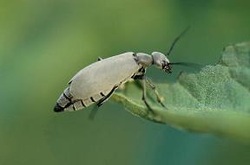
Some home gardeners like to use hand picking as a nonchemical method for controlling these large insects. However, wear gloves and use caution because these beetles contain a substance called cantharidin. This chemical is an irritant capable of blistering internal and external body tissues exposed to the chemical. On tender human skin, body fluids of adult blister beetles may cause large, erect, watery blisters.
Chemical control of blister beetles is also possible. Cyfluthrin (Bayer Vegetable and Garden Insect Spray) and gamma- or lambda-cyhalothrin (Spectracide Triazicide, Bonide Beetle Killer, Bonide Caterpillar Killer) can be used for control. Cyfluthrin has a 0 day waiting period and lambda-cyhalothrin has a 5-day waiting period on tomatoes. (Ward Upham)
Contributors: Ward Upham, Extension Associate; Cheryl Boyer, Extension Specialist
 RSS Feed
RSS Feed
